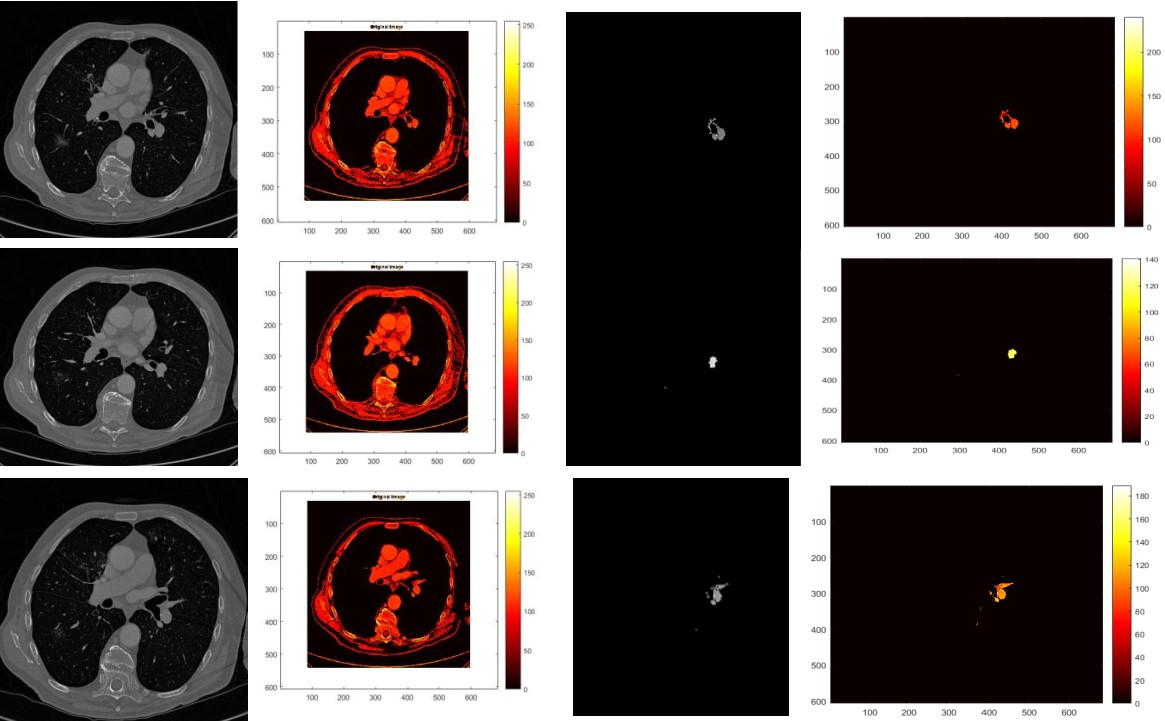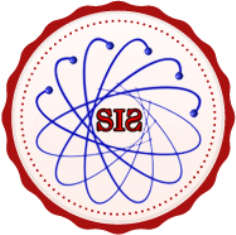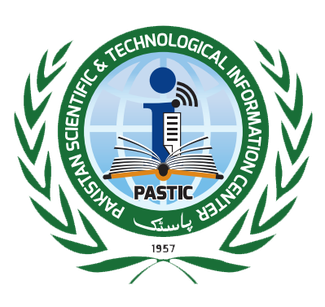Detection And Quantification of Lung Nodules Using 3D CT images
DOI:
https://doi.org/10.33411/ijist/2023050105Keywords:
Image segmentation, CT, Ray Projection, Frangi Filter, SFMAbstract
In computer vision image detection and quantification play an important role. Image Detection and quantification is the process of identifying nodule position and the amount of covered area. The dataset which we have used for this research contains 3D CT lung images. In our proposed work we have taken 3D images and those are high-resolution images. We have compared the accuracy of the existing mask and our segmented images. The segmentation method that we have applied to these images is Sparse Field Method localized region-based segmentation and for Nodule detection, I have used ray projection. The ray projection method is efficient for making the point more visible by its x, y, and z components. like a parametric equation where the line crossing through a targeted point by that nodule is more dominated. The Frangi filter was to give a geometric shape to the nodule and we got 90% accurate detection. The high mortality rate associated with lung cancer makes it imperative that it be detected at an early stage. The application of computerized image processing methods has the potential to improve both the efficiency and reliability of lung cancer screening. Computerized tomography (CT) pictures are frequently used in medical image processing because of their excellent resolution and low noise. Computer-aided detection systems, including preprocessing and segmentation methods, as well as data analysis approaches, have been investigated in this research for their potential use in the detection and diagnosis of lung cancer. The primary objective was to research cutting-edge methods for creating computational diagnostic tools to aid in the collection, processing, and interpretation of medical imaging data. Nonetheless, there are still areas that need more work, such as improving sensitivity, decreasing false positives, and optimizing the identification of each type of nodule, even those of varying size and form.
References
Q. Wu and W. Zhao, “Small-Cell Lung Cancer Detection Using a Supervised Machine Learning Algorithm,” Proc. - 2017 Int. Symp. Comput. Sci. Intell. Control. ISCSIC 2017, vol. 2018-February, pp. 88–91, 2018, doi: 10.1109/ISCSIC.2017.22.
L. Böröczky, L. Zhao, and K. P. Lee, “Feature subset selection for improving the performance of false positive reduction in lung nodule CAD,” IEEE Trans. Inf. Technol. Biomed., vol. 10, no. 3, pp. 504–511, 2006, doi: 10.1109/TITB.2006.872063.
M. Schultheiss et al., “Lung nodule detection in chest X-rays using synthetic ground-truth data comparing CNN-based diagnosis to human performance,” Sci. Rep., vol. 11, no. 1, pp. 1–10, 2021, doi: 10.1038/s41598-021-94750-z.
R. Sammouda, “Segmentation and analysis of CT chest images for early lung cancer detection,” Proc. - 2016 Glob. Summit Comput. Inf. Technol. GSCIT 2016, pp. 120–126, 2017, doi: 10.1109/GSCIT.2016.29.
F. Homayounieh et al., “An Artificial Intelligence-Based Chest X-ray Model on Human Nodule Detection Accuracy from a Multicenter Study,” JAMA Netw. Open, vol. 4, no. 12, pp. 1–11, 2021, doi: 10.1001/jamanetworkopen.2021.41096.
N. Khehrah, M. S. Farid, S. Bilal, and M. H. Khan, “Lung nodule detection in CT images using statistical and shape-based features,” J. Imaging, vol. 6, no. 2, 2020, doi: 10.3390/jimaging6020006.
R. Gruetzemacher, A. Gupta, and D. Paradice, “3D deep learning for detecting pulmonary nodules in CT scans,” J. Am. Med. Informatics Assoc., vol. 25, no. 10, pp. 1301–1310, 2018, doi: 10.1093/jamia/ocy098.
E. E. Nithila and S. S. Kumar, “Segmentation of lung nodule in CT data using active contour model and Fuzzy C-mean clustering,” Alexandria Eng. J., vol. 55, no. 3, pp. 2583–2588, 2016, doi: 10.1016/j.aej.2016.06.002.
D. Riquelme and M. Akhloufi, “Deep Learning for Lung Cancer Nodules Detection and Classification in CT Scans,” Ai, vol. 1, no. 1, pp. 28–67, 2020, doi: 10.3390/ai1010003.
A. C. M. et al. MacMahon, Heber, David P. Naidich, Jin Mo Goo, Kyung Soo Lee, Ann NC Leung, John R. Mayo, “Guidelines for management of incidental pulmonary nodules detected on CT images: from the Fleischner Society 2017,” Radiology, vol. 284, no. 1, pp. 228–243, 2017.
H. Cao et al., “A Two-Stage Convolutional Neural Networks for Lung Nodule Detection,” IEEE J. Biomed. Heal. Informatics, vol. 24, no. 7, pp. 2006–2015, 2020, doi: 10.1109/JBHI.2019.2963720.
M. S. A. Dwivedi, M. R. P. Borse, and M. A. M. Yametkar, “Lung Cancer detection and Classification by using Machine Learning & Multinomial Bayesian,” IOSR J. Electron. Commun. Eng., vol. 9, no. 1, pp. 69–75, 2014, doi: 10.9790/2834-09136975.
and X. X. Jiang, Beibei, Nianyun Li, Xiaomeng Shi, Shuai Zhang, Jianying Li, Geertruida H. de Bock, Rozemarijn Vliegenthart, “Deep learning reconstruction shows better lung nodule detection for ultra–low-dose chest CT,” Radiology, vol. 303, no. 1, pp. 202–212, 2022.
S. M. Naqi, M. Sharif, and M. Yasmin, “Multistage segmentation model and SVM-ensemble for precise lung nodule detection,” Int. J. Comput. Assist. Radiol. Surg., vol. 13, no. 7, pp. 1083–1095, 2018, doi: 10.1007/s11548-018-1715-9.
X. Li et al., “Multi-resolution convolutional networks for chest X-ray radiograph based lung nodule detection,” Artif. Intell. Med., vol. 103, p. 101744, 2020, doi: 10.1016/j.artmed.2019.101744.
S. Kido et al., “Segmentation of Lung Nodules on CT Images Using a Nested Three-Dimensional Fully Connected Convolutional Network,” Front. Artif. Intell., vol. 5, no. February, pp. 1–9, 2022, doi: 10.3389/frai.2022.782225.
M. Schultheiss et al., “A robust convolutional neural network for lung nodule detection in the presence of foreign bodies,” Sci. Rep., vol. 10, no. 1, pp. 1–9, 2020, doi: 10.1038/s41598-020-69789-z.
and S. H. Rehman, Muhammad Zubair, Nazri Mohd Nawi, Aisha Tanveer, Hassan Zafar, Hamza Munir, “Lungs cancer nodules detection from CT scan images with convolutional neural networks,” Int. Conf. Soft Comput. Data Min., pp. 382–391, 2020.
N. Sourlos, J. Wang, Y. Nagaraj, P. van Ooijen, and R. Vliegenthart, “Possible Bias in Supervised Deep Learning Algorithms for CT Lung Nodule Detection and Classification,” Cancers (Basel)., vol. 14, no. 16, pp. 1–15, 2022, doi: 10.3390/cancers14163867.
S. Fernandes et al., “Solitary pulmonary nodule imaging approaches and the role of optical fibre-based technologies,” Eur. Respir. J., vol. 57, no. 3, 2021, doi: 10.1183/13993003.02537-2020.
and Q. W. Tao, Haoyi, Yuanfang Qiao, Lichi Zhang, Yiqiang Zhan, Zhong Xue, “Anatomical Structure-Aware Pulmonary Nodule Detection via Parallel Multi-task RoI Head.,” Int. Work. Predict. Intell. Med., pp. 212–220, 2021.
and X. F. Lu, Yu, Huanwen Liang, Shijie Shi, “Lung Cancer Detection using a Dilated CNN with VGG16,” 2021 4th Int. Conf. Signal Process. Mach. Learn., pp. 45–51, 2021.
J. Zhang, K. Xia, Z. He, Z. Yin, and S. Wang, “Semi-Supervised Ensemble Classifier with Improved Sparrow Search Algorithm and Its Application in Pulmonary Nodule Detection,” Math. Probl. Eng., vol. 2021, 2021, doi: 10.1155/2021/6622935.
A. Naik and D. R. Edla, Lung Nodule Classification on Computed Tomography Images Using Deep Learning, vol. 116, no. 1. Springer US, 2021. doi: 10.1007/s11277-020-07732-1.

Published
How to Cite
Issue
Section
License
Copyright (c) 2023 International Journal of Innovations in Science & Technology

This work is licensed under a Creative Commons Attribution 4.0 International License.




















